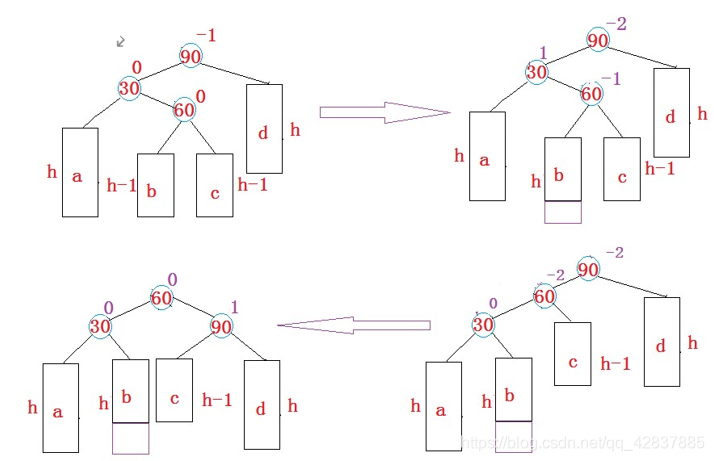AVL树的概念
- 一棵AVL树或者是空树,或者是具有以下性质的二叉搜索树:
- 它的左右子树都是AVL树
- 左右子树高度之差(简称平衡因子)的绝对值不超过1(-1/0/1)
AVL树的插入
AVL树就是在二叉搜索树的基础上引入了平衡因子,AVL树的插入过程可以分为两步:
- 按照二叉搜索树的方式插入新节点
- 调整节点的平衡因子
AVL树的旋转
如果在一棵原本是平衡的AVL树中插入一个新节点,可能造成不平衡,此时必须调整树的结构,使之平衡化。根据节点插入位置的不同,AVL树的旋转分为四种:
- 新节点插入较高左子树的左侧—左左:右单旋

- 新节点插入较高右子树的右侧—右右:左单旋

- 新节点插入较高左子树的右侧—左右:先左单旋再右单旋

- 新节点插入较高右子树的左侧—右左:先右单旋再左单旋

- 旋转完成后,原pParent为根的子树个高度降低到插入之前的高度,已经平衡,因此不需要再向上更新。
AVL树的验证
- 验证其为二叉搜索树
如果中序遍历可得到一个有序的序列,就说明为二叉搜索树 - 验证其为平衡树
- 每个节点子树高度差的绝对值不超过1
- 节点的平衡因子是否计算正确
AVLTree.hpp
#pragma once
#include<vector>
#include<iostream>
#include<stack>
using namespace std;
template<class T>
struct AVLTreeNode
{
AVLTreeNode(const T& data)
: _pLeft(nullptr), _pRight(nullptr), _pParent(nullptr)
, _data(data), _bf(0)
{}
AVLTreeNode<T>* _pLeft;
AVLTreeNode<T>* _pRight;
AVLTreeNode<T>* _pParent;
T _data;
int _bf;
};
template<class T>
class AVLTree {
typedef AVLTreeNode<T>* PNode;
typedef AVLTreeNode<T> Node;
public:
AVLTree()
:_Root(nullptr)
{}
~AVLTree() {
stack<PNode> arr;
PNode node = _Root;
while (!arr.empty() || node) {
while (node) {
arr.push(node);
node = node->_pLeft;
}
PNode del = arr.top();
arr.pop();
node = del->_pRight;
delete del;
}
}
bool Insert(const T& data){
if (!_Root) {
_Root = new Node(data);
return true;
}
PNode pParent=nullptr;
PNode pCur = _Root;
while (pCur) {
pParent = pCur;
if (data < pCur->_data)
pCur = pCur->_pLeft;
else if (data > pCur->_data)
pCur = pCur->_pRight;
else
return false;
}
pCur = new Node(data);
if (data < pParent->_data) {
pParent->_pLeft = pCur;
pCur->_pParent = pParent;
}
else {
pParent->_pRight = pCur;
pCur->_pParent = pParent;
}
while (pParent) {
if (pParent->_pLeft == pCur) {
--pParent->_bf;
}
else {
++pParent->_bf;
}
if (pParent->_bf == 0)
break;
if (pParent->_bf > 1 || pParent->_bf < -1) {
if (pParent->_bf == 2) {
if (pParent->_pRight->_bf == 1) {//左旋
RotateL(pParent);
}
else {//右左旋
RotateRL(pParent);
}
}
else {
if (pParent->_pLeft->_bf == -1) {//右旋
RotateR(pParent);
}
else {//左右旋
RotateLR(pParent);
}
}
break;
}
pCur = pParent;
pParent = pParent->_pParent;
}
return true;
}
PNode Find(const T& data) {
PNode ptr = _Root;
while (ptr) {
if (data < ptr->_data)
ptr = ptr->_pLeft;
else if (data > ptr->_data)
ptr = ptr->_pRight;
else
return ptr;
}
return nullptr;
}
//bool DelNode(const T& data);
bool IsBalanceTree() {
return IsAVLTree(_Root);
}
void Show() {
stack<PNode> arr;
PNode node = _Root;
while (!arr.empty() || node) {
while (node) {
arr.push(node);
node = node->_pLeft;
}
node = arr.top();
arr.pop();
cout << node->_data << " ";
node = node->_pRight;
}
cout << endl;
}
private:
void RotateL(PNode pParent) {
pParent->_bf = pParent->_pRight->_bf = 0;
PNode pPParent = pParent->_pParent;
PNode pRight = pParent->_pRight;
pParent->_pRight = pRight->_pLeft;
if (pRight->_pLeft)
pRight->_pLeft->_pParent = pParent;
pRight->_pLeft = pParent;
pParent->_pParent = pRight;
if (!pPParent) {
_Root = pRight;
pRight->_pParent = nullptr;
}
else {
if (pPParent->_pLeft == pParent) {
pPParent->_pLeft = pRight;
pRight->_pParent = pPParent;
}
else {
pPParent->_pRight = pRight;
pRight->_pParent = pPParent;
}
}
}
void RotateR(PNode pParent) {
pParent->_bf = pParent->_pLeft->_bf = 0;
PNode pPParent = pParent->_pParent;
PNode pLeft = pParent->_pLeft;
pParent->_pLeft = pLeft->_pRight;
if (pLeft->_pRight)
pLeft->_pRight->_pParent = pParent;
pLeft->_pRight = pParent;
pParent->_pParent = pLeft;
if (!pPParent) {
_Root = pLeft;
pLeft->_pParent = nullptr;
}
else {
if (pPParent->_pLeft == pParent) {
pPParent->_pLeft = pLeft;
pLeft->_pParent = pPParent;
}
else {
pPParent->_pRight = pLeft;
pLeft->_pParent = pPParent;
}
}
}
void RotateLR(PNode pParent) {
PNode pLeft = pParent->_pLeft;
PNode pLeftR = pLeft->_pRight;
int bf = pLeftR->_bf;
RotateL(pParent->_pLeft);
RotateR(pParent);
if (1 == bf) //最难最难的是这里的判断 花了好久才想到
pLeft->_bf = -1;
else if (-1 == bf)
pParent->_bf = 1;
}
void RotateRL(PNode pParent) {
PNode pRight = pParent->_pRight;
PNode pRightL = pRight->_pLeft;
int bf = pRightL->_bf;
RotateR(pParent->_pRight);
RotateL(pParent);
if (1 == bf)
pParent->_bf = -1;
else if (-1 == bf)
pRight->_bf = 1;
}
int Height(PNode pRoot) {
if (!pRoot)
return 0;
vector<PNode> v1;
vector<PNode> v2;
int count = 1;
v1.push_back(pRoot);
while (1) {
for (size_t i = 0; i < v1.size(); ++i) {
if (v1[i]->_pLeft)
v2.push_back(v1[i]->_pLeft);
else if (v1[i]->_pRight)
v2.push_back(v1[i]->_pRight);
}
v1 = v2;
v2.clear();
if (!v1.empty())
++count;
else
break;
}
return count;
}
bool IsAVLTree(PNode pRoot) {
if (!pRoot)
return true;
int left = Height(pRoot->_pLeft);
int right = Height(pRoot->_pRight);
if (right - left < -1 || right - left>1 || pRoot->_bf != right - left)
return false;
return IsAVLTree(pRoot->_pLeft) && IsAVLTree(pRoot->_pRight);
}
PNode _Root;
};
main.cpp
#include"AVLTree.hpp"
using namespace std;
void testAVLTree() {
AVLTree<int> tree_a, tree_b;
vector<int> a{ 16,3,7,11,9,26,18,14,15 };
vector<int> b{ 4,2,6,1,3,5,15,7,16,14 };
for (size_t i = 0; i < a.size(); ++i)
{
tree_a.Insert(a[i]);
}
for (size_t i = 0; i < b.size(); ++i)
{
tree_b.Insert(b[i]);
}
cout << tree_a.IsBalanceTree() << endl << tree_b.IsBalanceTree() << endl;
cout << tree_a.Find(7)->_data << endl << tree_b.Find(15)->_data << endl;
tree_a.Show();
tree_b.Show();
}
int main() {
testAVLTree();
_CrtDumpMemoryLeaks();
system("pause");
return 0;
}
